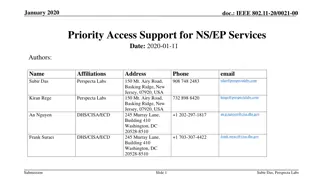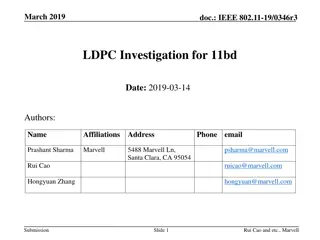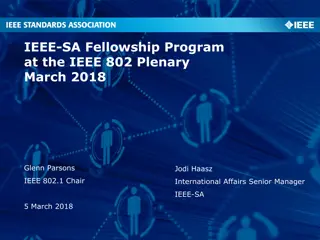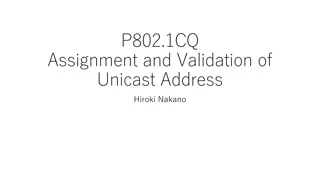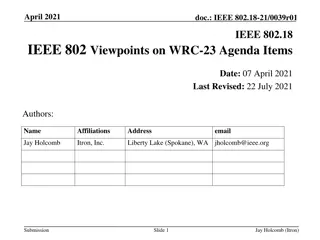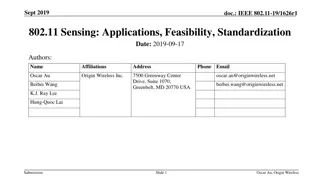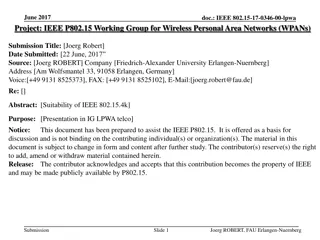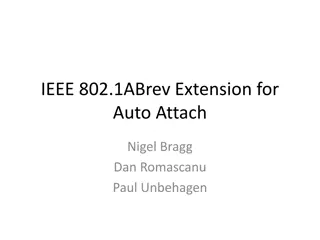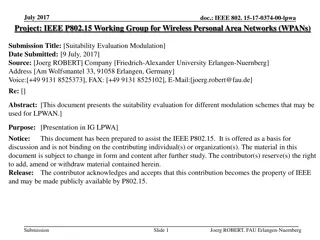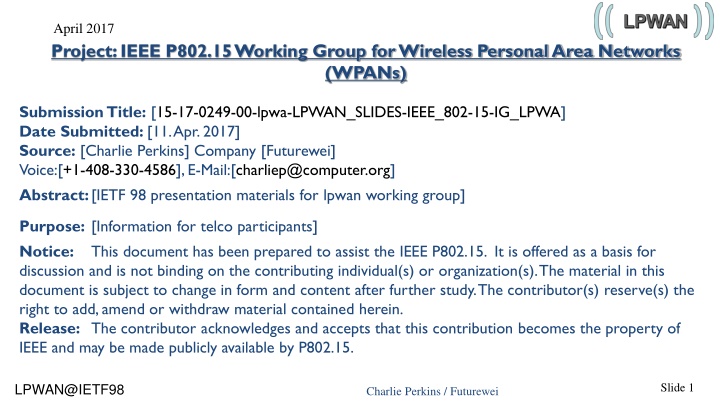
LP-WAN: Applications, Characteristics, and Advantages
Explore the world of LP-WAN technology with this detailed overview covering typical applications, key characteristics, and the benefits it brings. Discover how LP-WAN is revolutionizing industries with its low power consumption and long-distance capabilities.
Download Presentation

Please find below an Image/Link to download the presentation.
The content on the website is provided AS IS for your information and personal use only. It may not be sold, licensed, or shared on other websites without obtaining consent from the author. If you encounter any issues during the download, it is possible that the publisher has removed the file from their server.
You are allowed to download the files provided on this website for personal or commercial use, subject to the condition that they are used lawfully. All files are the property of their respective owners.
The content on the website is provided AS IS for your information and personal use only. It may not be sold, licensed, or shared on other websites without obtaining consent from the author.
E N D
Presentation Transcript
April 2017 Project: IEEE P802.15 Working Group for Wireless Personal Area Networks (WPANs) Submission Title: [15-17-0249-00-lpwa-LPWAN_SLIDES-IEEE_802-15-IG_LPWA] Date Submitted: [11. Apr. 2017] Source: [Charlie Perkins] Company [Futurewei] Voice:[+1-408-330-4586], E-Mail:[charliep@computer.org] Abstract:[IETF 98 presentation materials for lpwan working group] Purpose: [Information for telco participants] Notice: This document has been prepared to assist the IEEE P802.15. It is offered as a basis for discussion and is not binding on the contributing individual(s) or organization(s). The material in this document is subject to change in form and content after further study. The contributor(s) reserve(s) the right to add, amend or withdraw material contained herein. Release: The contributor acknowledges and accepts that this contribution becomes the property of IEEE and may be made publicly available by P802.15. Slide 1 LPWAN@IETF98 Charlie Perkins / Futurewei
An Introduction to IEEE 802 IG LPWA (Low Power Wide Area) Charlie Perkins <charles.perkins@earthlink.net> Joerg Robert <joerg.robert@fau.de> 98th IETF, Chicago, March 29th, 2016 LPWAN@IETF98 2
March 2017 Contents What are LP-WANs? Typical Applications and Characteristics Reason for the Low LP-WAN Bit-Rates Downlink Issues Costs of using IP Directly Channel Access Current Work in IEEE 802.15 LPWAN@IETF98 3 Joerg Robert, FAU Erlangen-Nuernberg
What are LP-WANs? Base-Station e.g. 100m e.g. 40km Sensor Node e.g. 10mW Small and cost-efficient sensor nodes transmit data over long distances with ultra- low power (1/10 of typical Wi-Fi transmit power) The sensor nodes are powered by tiny batteries (e.g. coin type) One base-station may serve millions of sensor nodes Multi-hop transmission is typically not used March 2017 LPWAN@IETF98 4 Joerg Robert, FAU Erlangen-Nuernberg
Typical Applications Application Alarms and Security Smoke Detectors Cattle Monitoring Logistics Smart Parking Smart Metering Structural Health Monitoring Description Monitoring of doors, windows, etc. Real time alerts, monitoring battery life,etc. Location and health monitoring of cattle Location and monitoring of goods Available parking space indication in real-time Automatic reading of gas/water meters Monitor structural health of bridges, etc. LP-WANs mostly address sensor applications Further use-cases are listed in [1] March 2017 LPWAN@IETF98 5 Joerg Robert, FAU Erlangen-Nuernberg
Typical LP-WAN Characteristics LP-WAN Wi-Fi Bit-Rate Latency Payload length Max. number of uplink packets / day < 1 kBps Up to minutes ~ 16 byte ~ 200 >> 1 Mbps << 1 s > 1 kbyte Millions Max. number of downlink packets / day < 20 Millions Max. distance w/o directive antennas Up to 40 km < 100 m Typical power supply Battery lifetime Typical frequency bands Coin type / AA Several years < 1 GHz Electrical Outlet / Li-Ion Hours (laptop/mobile) 2.4 GHz, 5.4 GHz March 2017 LPWAN@IETF98 6 Joerg Robert, FAU Erlangen-Nuernberg
Reason for Low LP-WAN Bit-Rates Minimum energy to transmit one bit Received power PRxis the transmitted power PTx minus the path loss from interference (noise) For a few details, see next three slides March 2017 LPWAN@IETF98 7 Joerg Robert, FAU Erlangen-Nuernberg
Reason for Low LP-WAN Bit-Rates (I/III) According to information theory the successful transmission of an information bit requires a certain energy The energy per bit is given by the reception power PRxdivided by the bit-rate R The theoretical maximum payload bit-rate is then given by [2]: 174 + . 1 + [ dBm ] dBm/Hz 59 dB P Rx = [ bit/s ] 10 R 10 Assumptions: Eb/N0=-1.59dB (information theoretic value for error-free decoding) Noise figure 0dB Noise power spectral density -174dBm/Hz max LPWAN@IETF98 March 2017 8 Joerg Robert, FAU Erlangen-Nuernberg
Reason for Low LP-WAN Bit-Rates ( II/III ) Path loss according to channel model The received power PRx[dBm] is given by the transmitted power PTx[dBm] minus the path loss PL[dB] {plus antenna gain, not considered here} The path loss PL[dB] for the outdoor-rural channel model [3] corresponds to PL=150dB for a distance of x=5000m So, at x=5000m, PRxequals 10dBm - 150dB = -140dBm Base-station antenna height: 30m Sensor node antenna height: 2m LPWAN@IETF98 9 Joerg Robert, FAU Erlangen-Nuernberg March 2017
Reason for Low LP-WAN Bit-Rates ( III/III ) Theoretical bit-rate according to slide 8 PRx[dBm] = -140dBm results in a maximum bit-rate of ? = 3 103Bit s = 3kBit/s Transmitting each bit is expensive! Packet overhead has significant impact March 2017 LPWAN@IETF98 10 Joerg Robert, FAU Erlangen-Nuernberg
Downlink-Issues The uplink and downlink have the same regulatory restrictions, but the base-station is more sensitive [4] Downlink is more critical than uplink The base-station may be able to receive from thousands of sensor nodes simultaneously, but it can only transmit to a single downlink node at a time [4] Only a few packets can be transmitted in the downlink Acknowledging uplink packets is impractical Due to downlink, LP-WANs are highly asymmetric March 2017 LPWAN@IETF98 11 Joerg Robert, FAU Erlangen-Nuernberg
Costs of using IP (and TCP) directly The typical payload length is only a few bytes. Even a few bytes overhead can significantly impact efficiency. Reduced battery life, increased channel load and latencies IP headers (for IPv4 / IPv6) are much longer than a typical LP-WAN payload. Connection oriented protocols (e.g. TCP) require significant downlink traffic, and further increase overhead. Gateways are very beneficial (as discussed within IETF [5]) March 2017 LPWAN@IETF98 12 Joerg Robert, FAU Erlangen-Nuernberg
March 2017 Channel Access Measured interference (Erlangen/Germany) Base-stations are often mounted on exposed sites, while sensor nodes are near the ground Very high uplink traffic [6] Algorithms such as CSMA have hidden node problems Significant levels of interference from other systems can be expected [7] Current research for LP-WANs focuses on improved channel access algorithms based on ALOHA, and methods to improve robustness (with respect to interference) LPWAN@IETF98 13 Joerg Robert, FAU Erlangen-Nuernberg
Current Work in IEEE 802.15 Interest Group (IG) LPWA is developing a report on use-cases and potential technologies for LP-WAN [1] Final IG report is expected end of July 2017 IG LPWA has already defined and analyzed: Use-cases Regulatory aspects Channel / interference models Current focus of IG LPWA is on analyzing: Suitability of existing IEEE standards of LP-WAN Candidate technologies and their suitability for LP-WAN (e.g. modulation, forward error correction, channel access, encryption, privacy, ...) [8] March 2017 LPWAN@IETF98 14 Joerg Robert, FAU Erlangen-Nuernberg
Procedure for Evaluating a Candidate Technology Analyze the general suitability of a candidate technology Suitability Analyze pros and cons, and dependency on other technologies Qualitative Evaluation Exact performance (for selected technologies) Quantitative Evaluation March 2017 LPWAN@IETF98 15 Joerg Robert, FAU Erlangen-Nuernberg
Use-Case Parameters for Evaluations Channel Model Interference Model Active Interfering Users Communication Mode Data Period Data Length Availability Frequency Regulation Cell Radius Data Security Node Velocity Latency Typical Power Supply LP-WAN Localization March 2017 LPWAN@IETF98 16 Joerg Robert, FAU Erlangen-Nuernberg
Example of Current Work Suitability Evaluation Use-case parameters are matched against the evaluation results. A use-case is not supported if any parameter is not supported (see next slide) [9] Example: Modulation DSSS (Direct Sequence Spread Spectrum) Spreading offers additional robustness, but fails in case of strong interference from other frequency users Spreading increases the required channel bandwidth and / or the length of the packets, making the data more vulnerable DSSS is not suitable if large Cell Radius is required LPWAN@IETF98 17 Joerg Robert, FAU Erlangen-Nuernberg
Results of the DSSS Suitability Evaluation on the Use-Cases Access Control Alarms and Security Asset Tracking Assisted Living Cattle Monitoring Field Monitoring Global Tracking Industrial Plant Condition Monitoring Industrial Production Monitoring Light Switch Pet Tracking Pipeline Monitoring -Terrestrial Public Lighting Smart Grid - Fault Monitoring Smart Grid - Load Control Smart Metering Smart Parking Smoke Detectors Structural Health Monitoring Vending Machines - general Vending Machines - privacy Waste Management Water Pipe Leakage Monitoring LPWAN@IETF98 18 Joerg Robert, FAU Erlangen-Nuernberg
Conclusion March 2017 LPWANs are mainly suitable for monitoring applications Long range communications results in very low payload bit-rates IP overhead is too large for many applications Channel access and interference are critical design considerations IG LPWA (within IEEE 802.15) is currently investigating LPWAN technologies and technical prospects of a new standard. The IG (Interest Group) report is expected in July 2017. A Study Group or Task Group might be formed as a result. LPWAN@IETF98 19 Joerg Robert, FAU Erlangen-Nuernberg
March 2017 ThankYou forYour Interest! LPWAN@IETF98 20 Joerg Robert, FAU Erlangen-Nuernberg
Literature March 2017 [1] IEEE 802.15, IG LPWA, LPWA Use-Cases, https://mentor.ieee.org/802.15/dcn/16/15-16-0770- 05-lpwa-lpwa-use-cases.xlsx [2] Proakis, J. G., Salehi, M.; Digital Communications, McGRAW-Hill, 2008 [3] IEEE 802.15, IG LPWA, Proposal for LPWAN Channel Models, https://mentor.ieee.org/802.15/dcn/17/15-17-0036-01-lpwa-proposal-for-lpwan-channel- models.pptx [4] IEEE 802.15, IG LPWA, LP-WAN Downlink Issues, https://mentor.ieee.org/802.15/dcn/17/15- 17-0164-00-lpwa-lp-wan-downlink-issues.pptx [5] IETF, LPWAN Overview, https://datatracker.ietf.org/doc/draft-ietf-lpwan-overview/ [6] IEEE 802.15, IG LPWA, Number of Active Interfering Users, https://mentor.ieee.org/802.15/dcn/17/15-17-0035-00-lpwa-number-of-active-interfering- users.pptx LPWAN@IETF98 21 Joerg Robert, FAU Erlangen-Nuernberg
Literature (cont.) March 2017 [7] IEEE 802.15, IG LPWA, Proposal for sub-GHz Interference Model, https://mentor.ieee.org/802.15/dcn/17/15-17-0037-01-lpwa-proposal-for-sub-ghz- interference-model.pptx [8] IEEE 802.15, IG LPWA, Candidate IEEE Standards and Technologies for IG Report, https://mentor.ieee.org/802.15/dcn/17/15-17-0211-01-lpwa-candidate-ieee-standards-and- technologies-for-ig-report.pptx [9] IEEE 802.15, IG LPWA, Candidate IEEE Standards and Technologies for IG Report , https://mentor.ieee.org/802.15/dcn/17/15-17-0228-00-lpwa-candidate-technology-qualitative- evaluation.pptx LPWAN@IETF98 22 Joerg Robert, FAU Erlangen-Nuernberg





